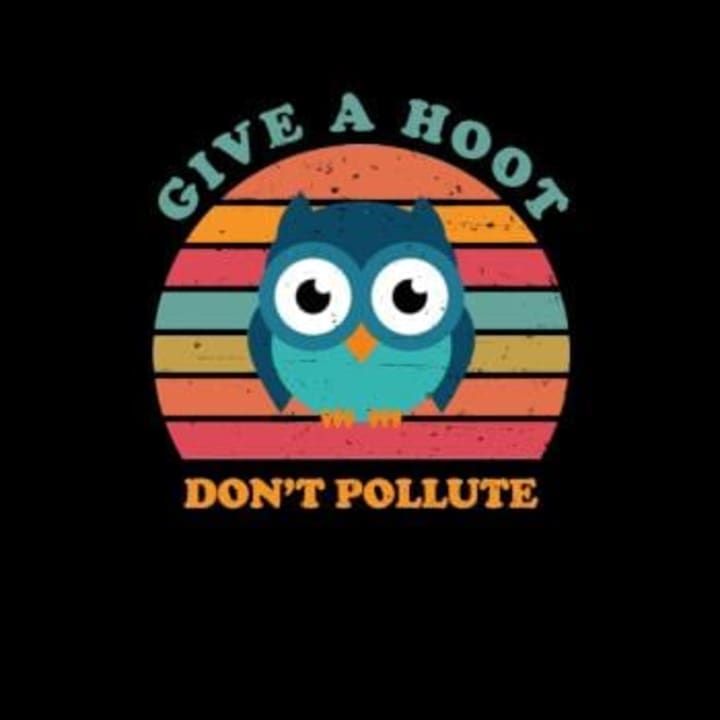The Repurpose Driven Life
5 Ways I Reduce My Carbon Footprint

The reason this meme is so funny is its accuracy. I remember opening my grandma's refrigerator to get out something she asked for and being overwhelmed by the butter containers and milk jugs that held everything but butter and milk. Due to my grandparents' age, they were used to keeping everything they thought they might use again. For my grandpa, it was screws, nails, nuts and bolts; stored in a coffee can.
More and more people are realizing how important it is to take care of our planet. It is the only one we have. Reducing our carbon footprint is not really difficult, and the benefits are incalculable. It's not all about carpooling any longer.
What's my plan?

Number 1-Textiles
The negative impact of carbon emissions released when creating some textiles far outweigh any possible fashion benefits. One of the worst textiles, using millions of barrels of oil each year in manufacturing, is polyester. Most polyesters are not biodegradable. Polyester garments that are thrown away might take as long as 200 years to degrade. Nylon, rayon and acrylic textiles are all similarly bad for the environment.
Looking for clothing made from recycled polyester, recycled cotton, hemp or linen are all better choices while I'm trying to reduce my carbon footprint. Another option, that is also kind to my wallet, is shopping for clothes at thrift shops. Thrift shops offer just about every color, size and style I could ask for at a fraction of retail prices.
Clothing manufacturing is second only to the oil industry in carbon emissions. Repurposing a shirt into a bag, like in the video above, helps in two ways. First, it turns the shirt into something practical and useful rather than it becoming refuse. Second, making it into a reusable shopping bag reduces the need for plastic bags.
Clothing that I no longer want can always be donated but if the items are no longer wearable, they can be crafted into something fun and useful.
Upcycling Fun
I really like the tie cell phone case because it can be a gentle reminder of a loved one who is gone. Bonus, I don't have to be able to sew to make it. The number of projects that can be done with used clothing is limited only by my imagination (and lack of sewing ability). Going through closets and getting rid of the clutter periodically, gives me plenty of textiles for projects.
Recycling Responsibility
If the textiles I have can't be donated or upcycled then the next option is recycling. According to the EPA, Americans throw out about 70 pounds of textiles a year and only 15% are recycled. They estimate that at least 5% of all trash in the landfill is recyclable textiles. Staggering. I'm not convinced that I throw out 70 pounds of textiles, but I know I haven't done enough to recycle.
There are drop boxes around our city for clothes that can be donated and different boxes for recyclable textiles. It's really convenient to drop off for anyone with a busy schedule. It helps me to go through closets to know I have somewhere to take clothes and other textiles I no longer need. Textile recycling is a straightforward way to shrink my carbon footprint.
Number 2- Grow my own dirt
Composting helps lower the amount of trash sent to the landfill and can create clean 'dirt' for my garden. I really don't have an actual garden at this point but, my yard could really use some good dirt mixed in for healthier grass. Even people who live in apartments can do a compost bin.
More important than what to put into your compost pile is what not to put in there. Don't compost meats, dairy, fats or oils because they create excessive odor and can draw pests and animals to your pile. Don't compost citrus or onions. The acidity from those items can kill worms and other microorganisms that are helping to break down the pile.
Also, don't add waste from carnivorous animals like dogs and cats. Herbivore waste is fine to add. Coffee and tea grounds are good to compost. Coffee filters and tea bags are not. Fruit and vegetable skins and scraps are great for compost as long as you remove the price sticker. Charcoal ash and treated woods will also ruin your compost pile.
Here is a list of more things to compost rather than send to the landfill:
- Grass clippings and leaves
- Small or chipped limbs and sawdust
- Black and white newspaper and printer paper
- Cardboard, paper towels and tissues
The smaller the items are, the faster they will compost. I tear large boxes into smaller pieces and cut larger limbs down before adding to my compost.
Number 3- The little things mean a lot.
Little things, like turning off a light, do more than save on the electric bill. Being energy efficient will reduce CO2 emissions. It takes no time and costs no money to turn off a light. I have already adjusted thermostat settings a few degrees, so I'm using less energy. Oddly enough, doing these things will also save me money.
Water bottles are a huge problem when it comes to CO2 and landfill totals. I don't care for the taste of tap water, so I have a Britta water pitcher. I have also accumulated a fair amount of reusable water bottles. This has ended some unnecessary trash to the landfill from me.
Washing clothes in cold water reduces my CO2 emissions and works just as well as other water temperatures. Cold water washing also helps to keep clothes from shrinking, colors from fading and reduces wrinkles. It also works just as well on stains, better on some. If someone is sick, washing clothes and bedding in higher water temperatures will kill germs. Otherwise, unless the garment tag says differently, cold water works just as well as hot.
Shopping can also help lower CO2 emissions. Not just any shopping. The reusable shopping bags really come in handy for this. Buy energy-efficient light bulbs. As my light bulbs need replacing, I use the LED 8-watt bulbs. They give off as much light as about a 60-watt incandescent bulb and use about 75% less energy. I also replaced my desktop computer with a laptop, look for products made with recycled materials, and try to shop from companies that are working to help the environment.
A small addition to the shopping, for me, includes buying gifts from companies who are working to help the environment. 4ocean offers some great gift options while helping to clean the trash from the oceans. If we lose the oceans, we all die shortly after.
Number 4- Transportation
It's not always practical to walk or ride a bike to the places I need to go so when I need to drive, there are ways to reduce CO2 emissions. First, I consolidate my trips. Where I live there are basically 3 areas that provide shopping for everything I need within a few blocks. North, East and West. If I need something specifically from a store on the west side of town, I go to the other stores in that location for everything else I need. Shopping just one day a week is another way I reduce driving.
I also check tire pressure, and keep up with oil changes, so my car doesn't have to work as hard. Accelerating slowly and taking my foot off the gas to slow down before a stop also helps to keep my cars emissions lower. I do try to stay within 5 miles of the posted speed limit.

Number 5- Old fashioned recycling
Recycling is not really difficult, but it can do so much good for the environment. The classic recycling item is the aluminum can. We used to cash in cans for spending money. There are so many more things that can be recycled now that my city provided everyone with a recycling bin. The bin is the same size as the trash can. Much of our trash can be recycled that is makes sense.
The only things my city asks us to do is make sure the recyclables are free from liquid and food debris. Also, not to bag the items before putting them in the bin. When looking at the list of acceptable items, that does include a good amount of my trash. Items include:
- Cardboard
- Chipboard (cereal box material)
- Newspapers, magazines, phone books, junk mail, catalogs
- Office paper and envelopes
- Aluminum and steel cans and lids
- Plastic containers with lids still on (milk jugs, soda bottles, etc)
- Dairy containers and lids (yogurt, butter, etc)
- Any color glass jars with lids

From the land to the sea
I have to admit that it took me a bit to connect a straw from my drink to the death of a marine animal. Having never even seen the ocean, I didn't realize how much damage I can do. If I drop my straw, and it ends up in the rain gutter then moves through the water system, it will end up in the Ohio River. From the Ohio River it will enter the Mississippi River then into the Gulf of Mexico. I looked at some pictures of what such carelessness is doing, and it was heartbreaking.
In Conclusion
Everyone needs to do their part in protecting the oceans' ecosystems. Marine animals don't recognize plastic debris as trash, all of it looks like any other floating food. When your dog swallows something they shouldn't or my cat tried to eat the tinsel off my Christmas tree; we can take them to a veterinarian for help. Marine life is swallowing our plastic or getting tangled in it and dying. Plastic is not biodegradable in the ocean. We can help them too. Just reduce, reuse and recycle.
Most of the activities that reduce my carbon footprint don't take much time. Many of them also save me money. By taking care of my little landlocked world, I can save the lives of marine animals and help keep the oceans clean. I don't see a downside. Who knew it was this easy to save the world?
About the Creator
Yvonne Lovejoy
Writing has always been a part of me. My dream could die with failure or would live on if I never tried. Time for that to change. Follow me https://linktr.ee/YvonneWriting and be sure to click like on any stories you enjoy.






Comments
There are no comments for this story
Be the first to respond and start the conversation.